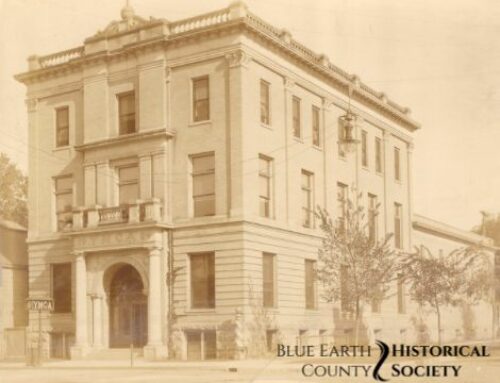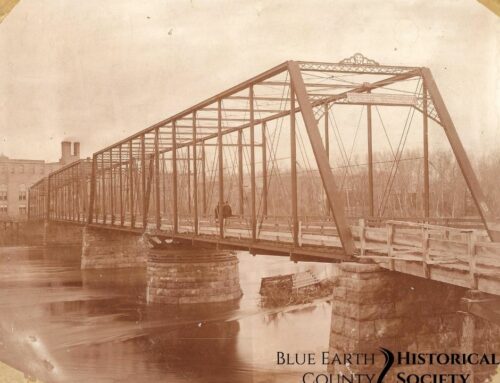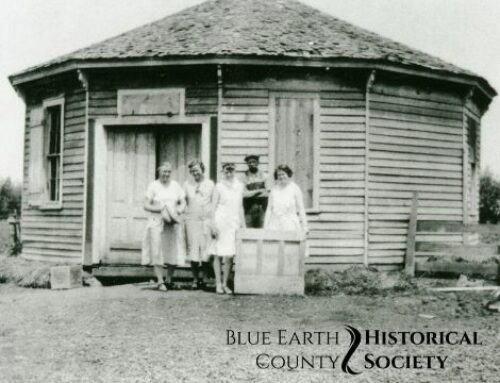1862 was a dark year for Minnesota. In the shadow of the Civil War, another war came to the area, what we today call the U.S.-Dakota War. The war lasted only six weeks, killed hundreds of white settlers and Dakota Indians, laid waste to the Minnesota River Valley and turned New Ulm and the area around it into a battleground. Plenty of blame has been thrown back and forth by both sides as to who started it. Bad and heroic deeds were done on both sides, and it is not our place to sit in judgment anymore. We will probably never know the full truth of what happened.
Unfortunately, ambiguity also swirls around a relic the Blue Earth County Historical Society possesses, a 19-foot notched, wooden timber that may or may not have been a cross piece from the gallows where 38 Dakota men were hanged December 26, 1862.
There have been calls this year, the 150th anniversary year, to bring the timber out of storage and let people look at it, and even accusations that the Blue Earth County Historical Society is trying to hide it. Nothing could be further from the truth. The fact is, the Blue Earth County Historical Society, acting on its primary mission as a steward to the county’s history is taking its research into the timber very seriously.
An artifact of this kind has to be handled with care and sensitivity, both for the preservation of the artifact itself, and for the people whose ancestors were affected by the original event. As we have seen this year, emotions still run high around the subject of the U.S.-Dakota War, even 150 years later. Here at the Blue Earth County Historical Society in Mankato we have been using our historical resources to get a better understanding of whether this timber is, in fact, a cross-piece beam from the gallows or just a floor joist from a building on Front Street. We have consulted with the Minnesota Historical Society and the University of Minnesota.
Let’s look at what we do know (click here for an expanded historical timeline rather than the following condensed version).
• The Blue Earth County Historical Society received the timber from the University of Minnesota in 1927.
• The University received it in 1881 from Mankato businessman John Meagher, who sent a note with it saying it was a genuine piece of the gallows.
• Mr. Meagher was a Mankato resident who built and owned several buildings in Mankato. He arrived in Blue Earth County in 1858 as a Tinner, served with a volunteer company during the U.S.-Dakota War and went on to be one of the most influential citizens in Mankato.
• The gallows were built December 21-22, 1862, and only one Mankato newspaper gave a firsthand account of its construction. The scaffold was a large, four-sided structure, measuring 24 feet on each side and 14 feet high. Each of the cross pieces, from which the ropes hung, were 12 by 12 inches by 24 feet. Each cross piece had ten notches cut in it. (The timber at the Blue Earth County Historical Society is 8 by 10 inches and 19 feet long and has many notches of various widths.)
• In August 1864, the Mankato Weekly Union and the Mankato Weekly Record reported that the structures related to the hanging were sold at a public government auction. Dr. S.D. Brown of Mankato purchased the gallows and the log prison. In March 1865, Dr. Brown complained to the sheriff that someone was stealing “timber” from his property. (Whether this was the gallows timber or other timber is unclear.) From here, the trail of the gallows timber goes cold for the next 17 years.
• On April 3, 1881, Dr. Brown died. According to his will, all his possessions, which included real estate, was left to his wife Amelia.
• In the next two weeks, the Mankato Review and the Mankato Free Press reported that one of Mr. Meagher’s buildings, which was torn down around the beginning of April 1881, contained multiple timbers from the gallows, and one of them “has been presented to the State University Museum, and will soon be forwarded to Minneapolis” (Mankato Review). That building was originally built in 1856 and expanded by Meagher in the fall of 1865.
• The November 11, 1881 issue of The Ariel, (a U of M newspaper) notes the arrival of the timber at the University of Minnesota during the previous summer. The article quotes the note from Mr. Meagher: “Agreeable to promise I have sent the last stick of the ‘Indian Gallows’ this p.m. to the St. Paul & Sioux City depot to be forwarded to the University of Minnesota….” Eric Moore, Acting Head of University Archives at the U of M, told the Blue Earth County Historical Society in March 2012 that “this newspaper article is the only reference I can find to the timber coming to the U. The General Museum at the time was basically the geology and archeology museum. The annual reports for the Regents and the Geological and Natural History Survey, which oversaw the museum, make no reference to acquiring it. I also cannot find a reference to it leaving in 1927.”
• In July 1896, the Mankato Free Press reported that a warehouse containing pieces of the gallows burned down the previous night. It also reported Meagher bought the gallows timber at auction. It does not specify whether this auction was the government auction in 1864 or a later one. However, this claim was disputed in a later edition of the Free Press by W.H. Pay whose father built the warehouse and denies that any scaffold timbers were used in the construction.
In reality, the only evidence we have that this is a genuine cross piece from the gallows is the word of John Meagher when he donated it to the University of Minnesota in 1881 as he was not the buyer at the government auction.
The Blue Earth County Historical Society uses provenance to determine authenticity. This concept of provenance, a clear, demonstrable trail of ownership, means everything in the world of historical research, antiques, art and archaeology.
What would constitute reliable evidence or provenance? Here are some options:
• Some kind of first-hand account, written at the time that clearly explains how the timber passed from the government auction to Mr. Meagher.
• A genuine record tracing how the real gallows timbers passed from Dr. Brown’s possession into Mr. Meagher’s.
• Some kind of photographic record that can show clearly that the timber in our collection was part of the scaffold. There are no known photographs of the scaffold, only a variety of artist’s drawings.
• Certain kinds of testing could be done on the wood to establish an age. This kind of testing could pin a more accurate date on the timber, but it also costs several thousand dollars. And it may only verify what we know, it was used in the construction of a building in the mid-1800s.
You might look at this and say, “Well, it’s impossible for any of those options to prove conclusively that that timber was part of the gallows.” And there is the heart of the problem. Because, due to the nature of record keeping—or absence of it—it is highly unlikely we ever will find that indisputable proof. And therefore, it is highly unlikely we will ever be able to say with absolute certainty this is a piece of the scaffold.
For more information:





Leave A Comment